Whether you’re a real estate investor, business owner, or homeowner, understanding the difference between Fed rate vs mortgage rate is crucial. While the Federal Reserve sets the Fed rate to manage inflation and stabilize the economy, mortgage rates are influenced more by long-term bonds, although there is a definite link between the two.
At Defy Mortgage, we provide highly customizable financing solutions for all different types of borrowers, including HELOCs for homeowners, DSCR loans for real estate investors, P&L loans for business owners, and more. We simplify the loan process with speedy pre-approvals and over 75 different expertly crafted solutions for even the most challenging financial circumstances.
Given our industry expertise, it’s our responsibility to know how the Fed rate influences interest rates and what that means for borrowers. This blog explains the link between the Fed rate and mortgage rates, offering a clear overview of how the Federal Reserve rate works, its impact on mortgage rates, and why they don’t always move in sync.
Let’s dive in.
What Is the Federal Reserve Rate?
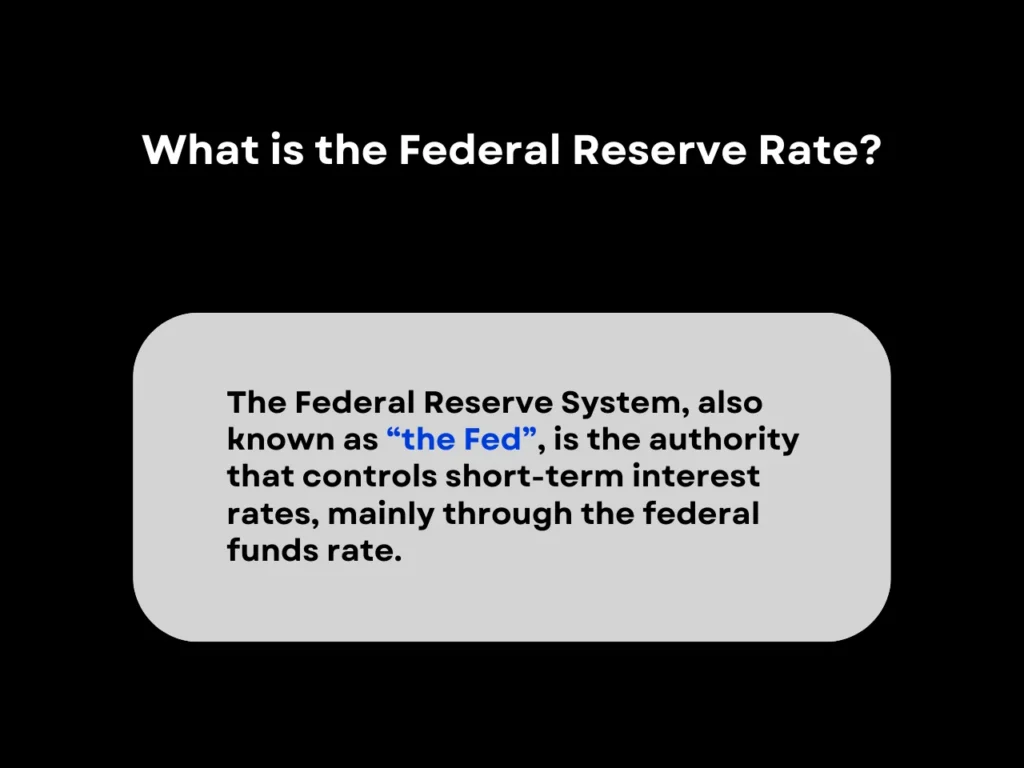
The Federal Reserve System, also known as “the Fed,” is the authority that controls short-term interest rates, mainly through the federal funds rate. When comparing the Fed rate vs mortgage rate, keep in mind that mortgage rates follow the federal funds rate, but they rarely have a 1:1 relationship.
Federal Funds Rate Definition
The federal funds rate refers to the interest rate applied to the overnight loans that banks lend to one another to meet reserve requirements, which are the funds held in reserve to cover customer withdrawals. It is a policy interest rate, serving as the benchmark interest rate set by central banks to maintain stable economic conditions. The Fed funds rate is determined by the Federal Reserve, serves as the basis for many other interest rates, and is thus a major determiner of economic activity.
The federal funds rate aims to influence the interest rates that every other lending service in the country uses, from consumer loans and credit cards to mortgages. When the economy needs boosting, the Fed can lower the Fed rate to attempt to lower all other interest rates and encourage borrowing across the board. Conversely, they can raise the rate to discourage borrowing when inflation is rising too quickly. This approach helps temper inflation or promote steady economic development as needed.
Types of Federal Reserve Rates
The federal funds rate can be divided into two categories: the effective federal funds rate and the target federal funds rate.
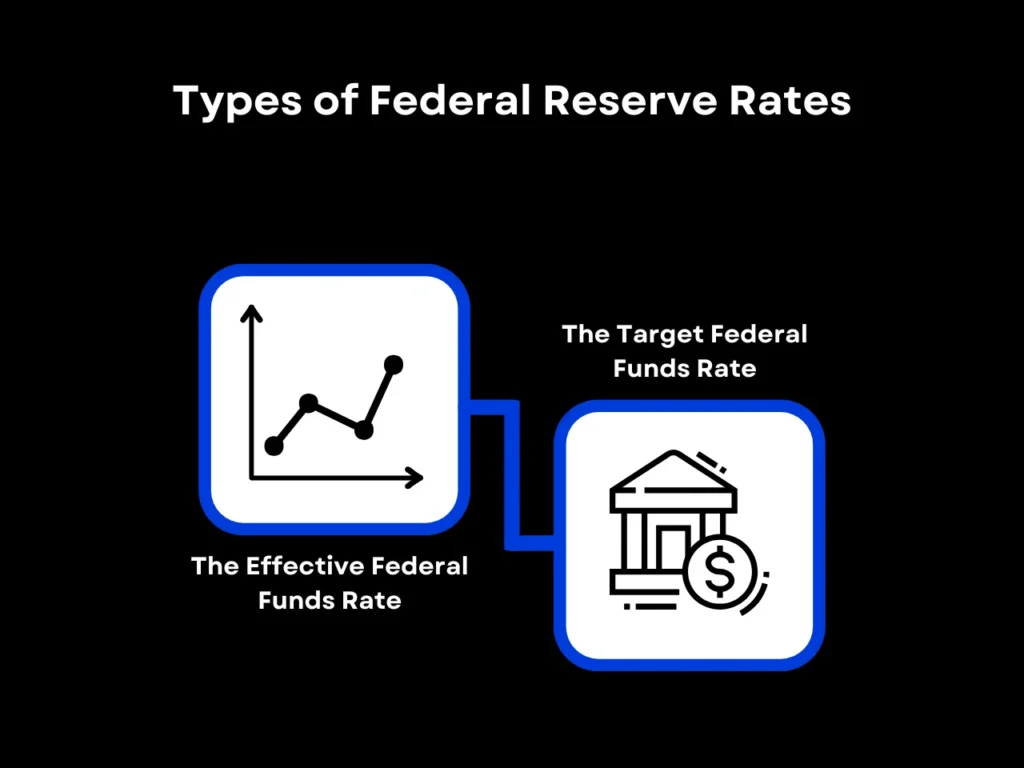
The Effective Federal Funds Rate
The effective federal funds rate (EFFR) is the weighted average interest rate that depository institutions, such as commercial banks, charge each other for overnight loans in the federal funds market. It is calculated as a volume-weighted median based on overnight transactions and is reported daily by the New York Federal Reserve.
This differs from the actual rate set by the Federal Reserve because of sudden changes in the supply and demand for these overnight loans. For example, if several of a bank’s clients withdraw large sums, it may be left with lower liquidity or, in simpler terms, less cash, leading to the bank raising its interest rates for overnight loans to compensate for the risk of having lower liquidity.
The Target Federal Funds Rate
The target federal funds rate is the rate that the Fed actually set during meetings of the Federal Open Market Committee (FOMC). Fluctuating market conditions make it difficult for institutions to keep their rates exactly at the rate set by the Fed.
So, when the effective federal funds rate differs too much from the target, the Fed may intervene with open market operations to bring the effective rate closer to the target rate. Because of the variable nature of the effective federal funds rate, the target rate is often actually a target rate range.
Differences Between Fed Rate and Mortgage Rate
When comparing the Fed rate vs mortgage rate, there is a common misconception that the Fed rate directly dictates mortgage rates. However, this isn’t entirely true. It is more accurate to say that changes to the Fed rate can create circumstances that influence mortgage rates. IE: the Federal Reserve influences mortgage rates, but doesn’t set them. Here’s how it works:
Short-Term vs Long-Term Rates
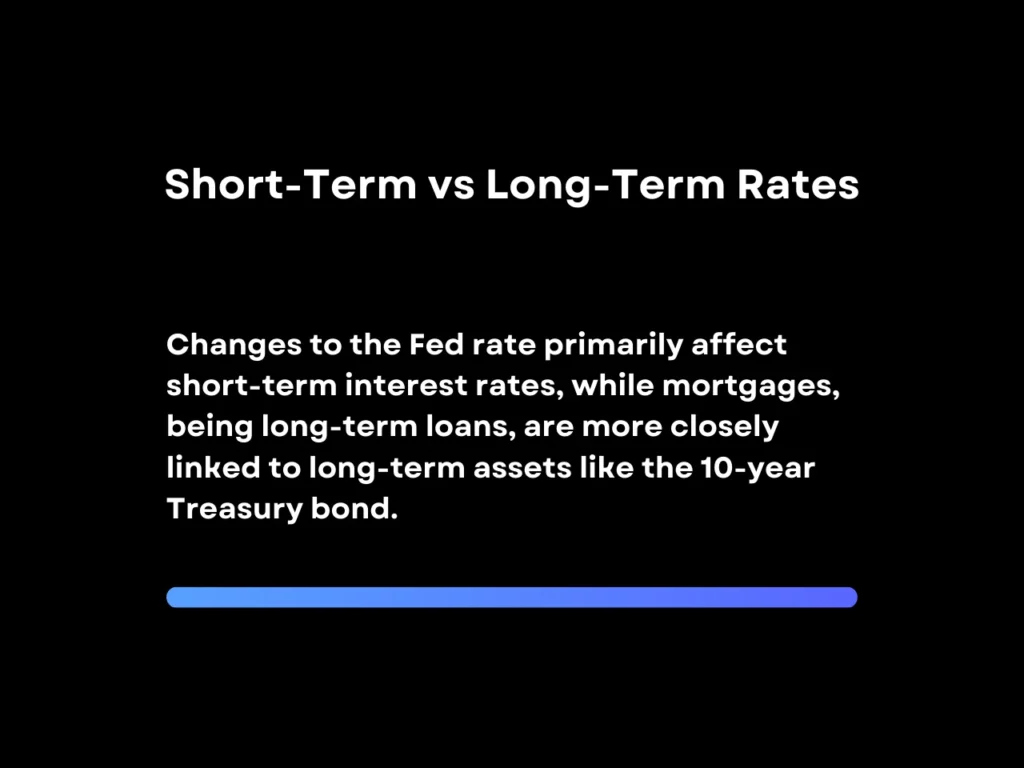
Changes to the Fed rate generally influence short-term interest rates, while mortgages are long-term loans and, as such, are more closely tied to long-term financial assets, like the 10-year Treasury bond. During high inflation or volatile markets, investors may seek safer long-term assets like bonds, which can lower mortgage rates. Conversely, if inflation expectations rise, mortgage rates may increase to protect against declining purchasing power.
This is why the demand for bonds among investors is one of the most significant factors impacting mortgage rates. Other factors include inflation expectations and general market circumstances directly related to mortgages (such as housing supply and demand and economic growth trends).
Why They Don’t Always Move Together
The Federal Open Market Committee’s monetary policy decisions play a key role in shaping mortgage rates, but they aren’t the only determining factor. Economic conditions have a significant impact too – from inflation levels and employment growth to overall economic expansion or contraction. These various forces work together to influence the direction of mortgage rates.
General Market Factors
Although the Federal Reserve and mortgage rates are connected through the Fed rate, they don’t always move in tandem. Market factors and economic outlook can influence mortgage rates by shifting investor sentiment. For instance, when investors anticipate inflation, they may demand higher returns, increasing mortgage rates.
Lack of investor demand for long-term bonds also increases their yields, prompting lenders to raise mortgage rates to maintain their profit margins and attract investors since higher bond yields make bonds more attractive than mortgage-backed securities.
Global Economic Events
Global economic events can also be a more significant factor in shaping inflation expectations and housing market conditions. For example, during the 2008 financial crisis, mortgage rates initially fell as the Federal Reserve slashed the Fed rate to near-zero levels to stabilize the economy.
However, mortgage rates didn’t drop as much as expected because investors lacked confidence in mortgage-backed securities. This caused the housing market to crash and led to widespread defaults, dropping the demand for long-term bonds and mortgage-backed assets, which pushed mortgage rates higher despite the Fed’s efforts.
A similar scenario happened in 2023, when mortgage rates remained high despite the Fed cutting rates because 10-year treasury bonds were forecast to continue to have higher yields, significantly decreasing the demand for 30-year mortgage bonds. Although Fed policy decisions do matter, they can be outweighed by investors preferring short-term bonds if mortgage bonds do not offer high enough returns to be worth the risk.
What Homebuyers and Investors Should Know
For homebuyers and investors, it pays to understand how the Fed rate can affect your investment, as well as tools and strategies that can help you plan accordingly. Consider the following:
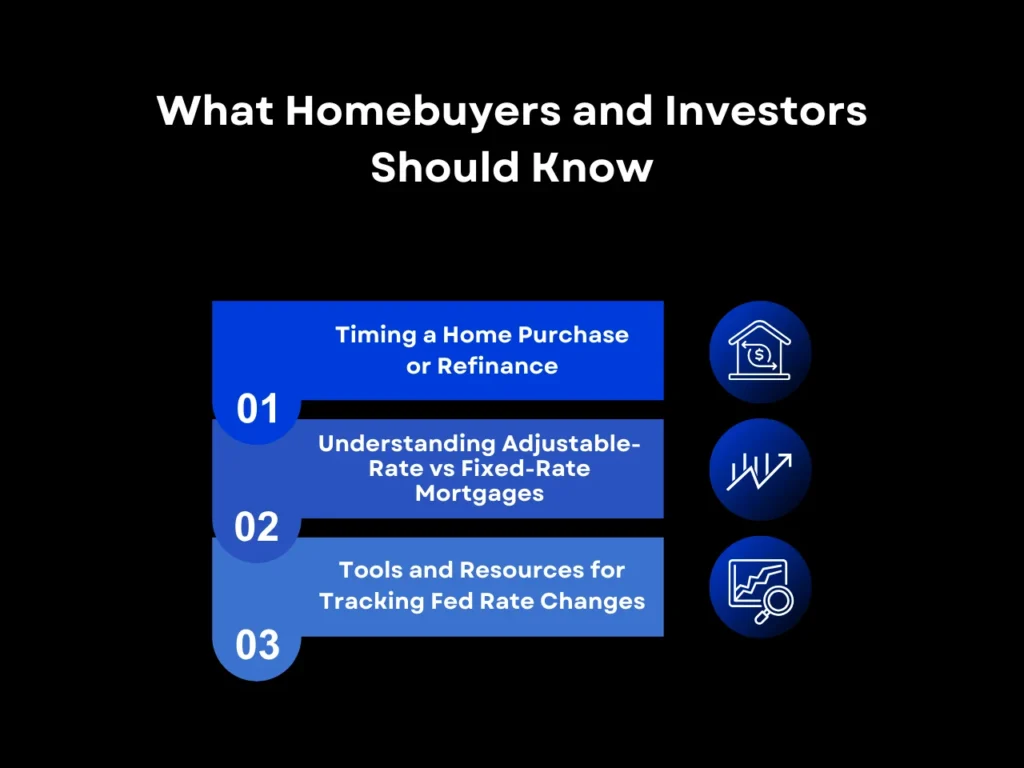
Timing a Home Purchase or Refinance
The best time to buy a home is ultimately whichever time works best for your unique situation. However, it’s important to consider that historically, homebuyers saw the best cost-to-benefit ratio before predicted Fed rate hikes or during Fed rate dips. Buying with a fixed-rate mortgage before a predicted hike or during a dip will let you lock in a lower rate ahead of mortgage rate increases.
When the Federal Reserve increases the federal funds rate, mortgage rates may take a few days to adjust. This can give you a brief opportunity to lock in lower rates before lenders adjust them according to the Fed rate, but some may raise their rates ahead of time if there’s enough indication that the Fed will do the same.
Conversely, when the Fed lowers rates, it’s worth evaluating whether to refinance, especially for adjustable-rate mortgages (ARMs), which are more sensitive to changes in the Fed rate. Refinancing is best for those who are looking to lower their interest rate, reduce their monthly payments, shorten their loan term, fund large expenses, or consolidate debt.
If mortgage rates are your main driving factor behind a refinance, you may want to explore rate-and-term refinancing, which is a type of mortgage refinancing that focuses on changing your interest rate, loan term, or both rather than withdrawing equity in cash.
Understanding Your Lending Options
Several kinds of financing products are particularly affected by changes in mortgage rates. Each of these is best for certain types of borrowers and interacts with mortgage rate changes differently.
Cash-out Refinancing
Cash-out refinancing lets you refinance into a larger mortgage, which, after paying off your primary mortgage and any secondary liens, gives you the difference in cash. This type of refinancing is best for those who need a large sum of cash, such as for home improvements, real estate investment, or debt consolidation. Cash-out refinancing typically has a fixed rate, so choosing this option when mortgage rates are low can save you thousands in interest payments.
Rate-and-Term Refinancing
Rate-and-term refinancing, in contrast to cash-out refinancing, lets you refinance into a mortgage with a different rate or loan term or both, as well as other terms like changing from a fixed-rate mortgage to an adjustable-rate one, without having to change the principal balance of the loan.
This type of refinancing is ideal for those who want to reduce their interest payments or pay off their mortgage faster. Since it allows borrowers to switch to a different loan type, rate-and-term refinancing can also let them switch to a fixed interest rate to lock their mortgage at a lower rate. Conversely, it can also let borrowers take advantage of favorable economic trends by switching to an adjustable rate.
Investment Property Loans
Investment property loans are a category of mortgage that are specifically intended for purchasing or refinancing investment properties. Best for individuals like real estate investors and landlords, investment property loan rates can be higher than that of a primary residence mortgage due to the lender perceiving higher risk. Since investment property loans are generally fixed-rate mortgages, it can be advantageous to avail of them while rates are low to minimize the effect that lenders’ perceived risk can have on your interest rate.
Self-Employed Mortgages
Designed for entrepreneurs, freelancers, and small business owners, self-employed mortgages offer greater loan flexibility for those with unconventional sources of income. These can come in both fixed-rate and adjustable-rate forms, with interest-only options that allow you to forgo paying principal payments for a set period. Locking in an interest-only self-employed mortgage at low interest can give you plenty of financial breathing room early in the life of your loan.
Jumbo Loans
Jumbo loans are intended for properties that are priced beyond the Federal Housing Finance Agency’s conforming loan limits. Best suited for very large properties or those in luxury markets, jumbo loans can have stringent requirements such as a large down payment of up to 25% and a FICO score of above 700. Those who don’t meet these requirements can still be approved, albeit with a higher interest rate, but timing a purchase with a jumbo loan with low mortgage rates can help compensate for this.
Understanding Adjustable-Rate vs Fixed-Rate Mortgages
Adjustable–rate mortgages (ARMs) are more vulnerable to changes in the Fed rate because these loans are adjusted periodically based on short-term interest rates. By contrast, fixed-rate mortgages have the same interest rate throughout the loan’s life and are thus shielded from fluctuations in the Fed rate. This makes fixed-rate mortgages preferable for those seeking long–term stability.
To make informed mortgage decisions, track changes in the current federal funds rate and consult with mortgage experts. ARMs can be more advantageous if lower interest rates are forecast, providing lower initial payments and potential savings, but during periods of economic uncertainty, fixed-rate mortgages may be the better option.
Tools and Resources for Tracking Fed Rate Changes
Various tools and resources are available to effectively track changes in the Federal Reserve’s interest rates. The Federal Reserve’s official website is the primary source for updates to the Fed rate and other monetary policies. You can also check platforms like Business Insider for updated data on average mortgage rates, or alternatively, use Defy’s Mortgage Calculator to get an accurate estimate of your monthly mortgage payment.
Financial news outlets like Bloomberg and CNBC frequently report on Fed rate adjustments and their implications for the economy and mortgage markets. Defy’s blog frequently reports on policy updates that could affect lending options, like the 0.50% Fed rate cut in September 2024. You can also refer to the Fed’s official calendar on its website to learn the dates for upcoming Federal Open Market Committee (FOMC) meetings.
Fed Rate vs Mortgage Rate FAQs
Does the Federal Reserve Directly Set Mortgage Rates?
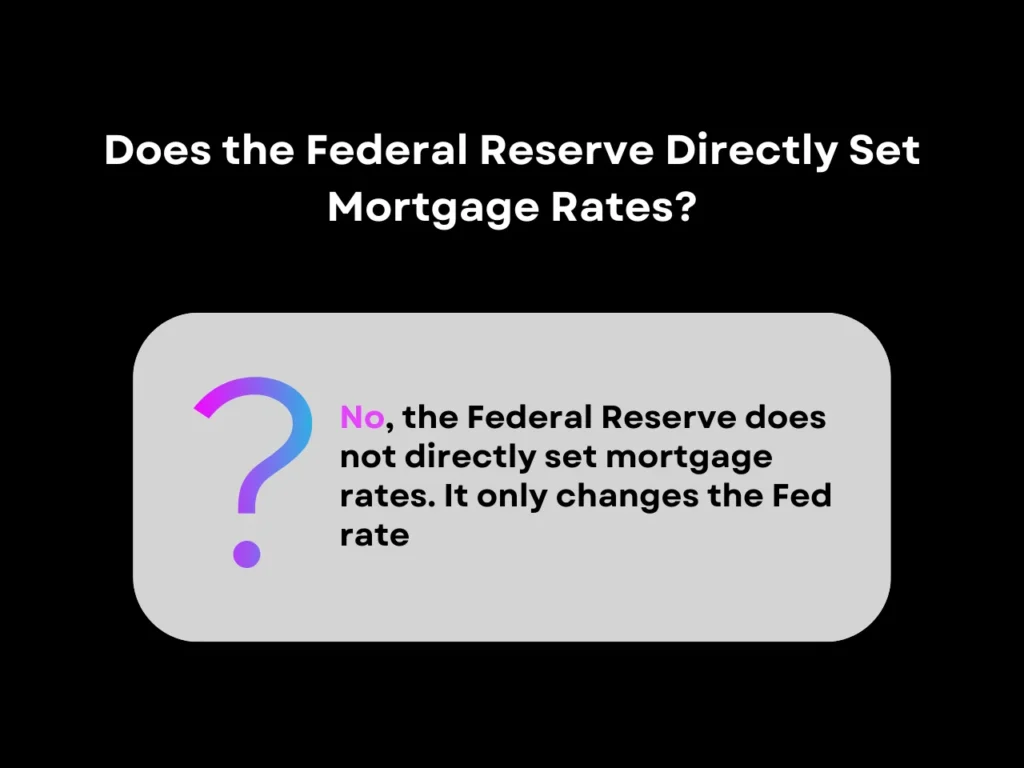
No, the Federal Reserve does not directly set mortgage rates. It only changes the Fed rate, which can influence mortgage rates, especially those with shorter terms.
How Often Does the Federal Reserve Change the Fed Rate?
The Fed rate is typically adjusted during regularly scheduled meetings of the Federal Open Market Committee (FOMC), which take place roughly eight times a year.
Can Mortgage Rates Go Up Even if the Fed Rate Stays the Same?
Yes, even if the Fed rate remains stable, mortgage rates can still rise. Key factors that can cause this are changes in inflation expectations and investor demand for long-term bonds.
How Long After a Fed Rate Change Do Mortgage Rates Typically Adjust?
Mortgage rates may not immediately change following a Fed rate adjustment and can take days to follow suit. The timeline can vary based on the market, the type of mortgage, and investor sentiment.
Should I Refinance My Mortgage if the Fed Rate Drops?
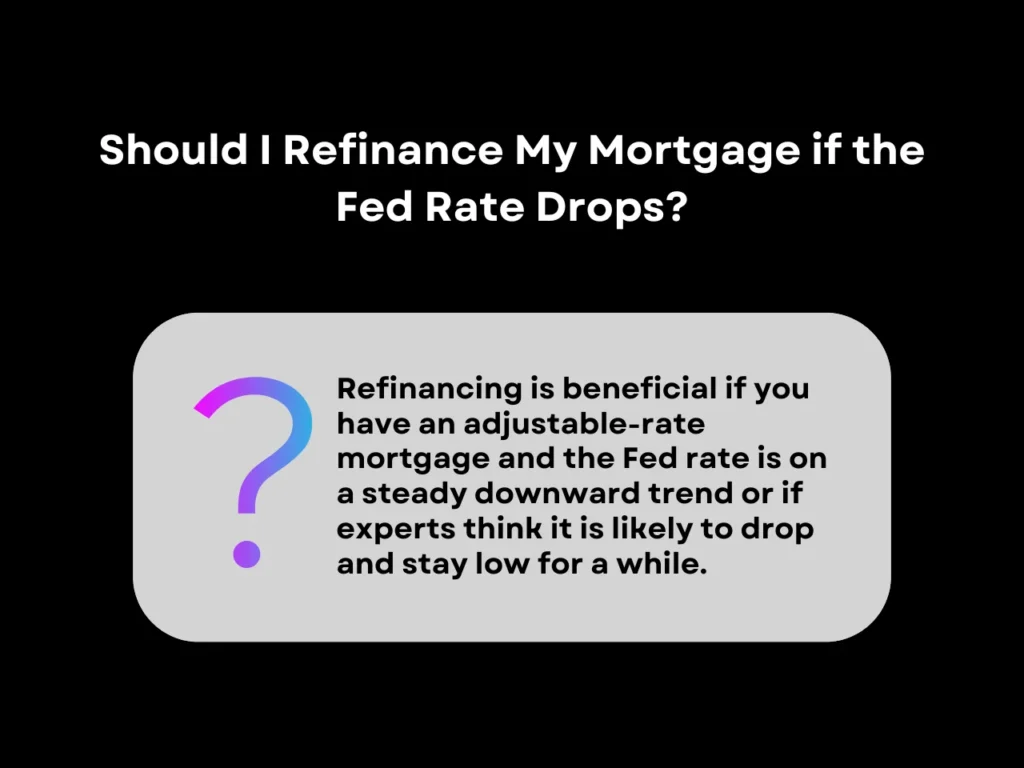
Refinancing is beneficial if you want to renegotiate your mortgage’s terms or if you need to fund large expenses. Borrowers tend to get the best results if they refinance into an adjustable-rate mortgage and the Fed rate is on a steady downward trend or if experts think it is likely to drop and stay low for a while. Those with fixed-rate mortgages will not see any benefit from a Fed rate cut, but they will not be harmed by Fed rate increases either.
Key Takeaway
When considering the Fed rate vs mortgage rate, remember that the Fed rate is more of a guideline set by the Federal Reserve to regulate mortgage rates and other interest rates. Mortgage rates, on the other hand, are shaped by various market factors, with long-term bonds and investor sentiment being the most significant.
Understanding the distinction and relationship between the Fed rate vs mortgage rate will help you make smarter decisions when buying or refinancing a property. If you’re planning on doing so soon, keep in mind the best times to purchase or refinance, as well as the pros and cons of fixed-rate mortgages and ARMs.
Would you like some expert advice on your mortgage? Don’t hesitate to schedule an appointment with Defy for a free consultation. Our mortgage experts can help point you in the right direction.







